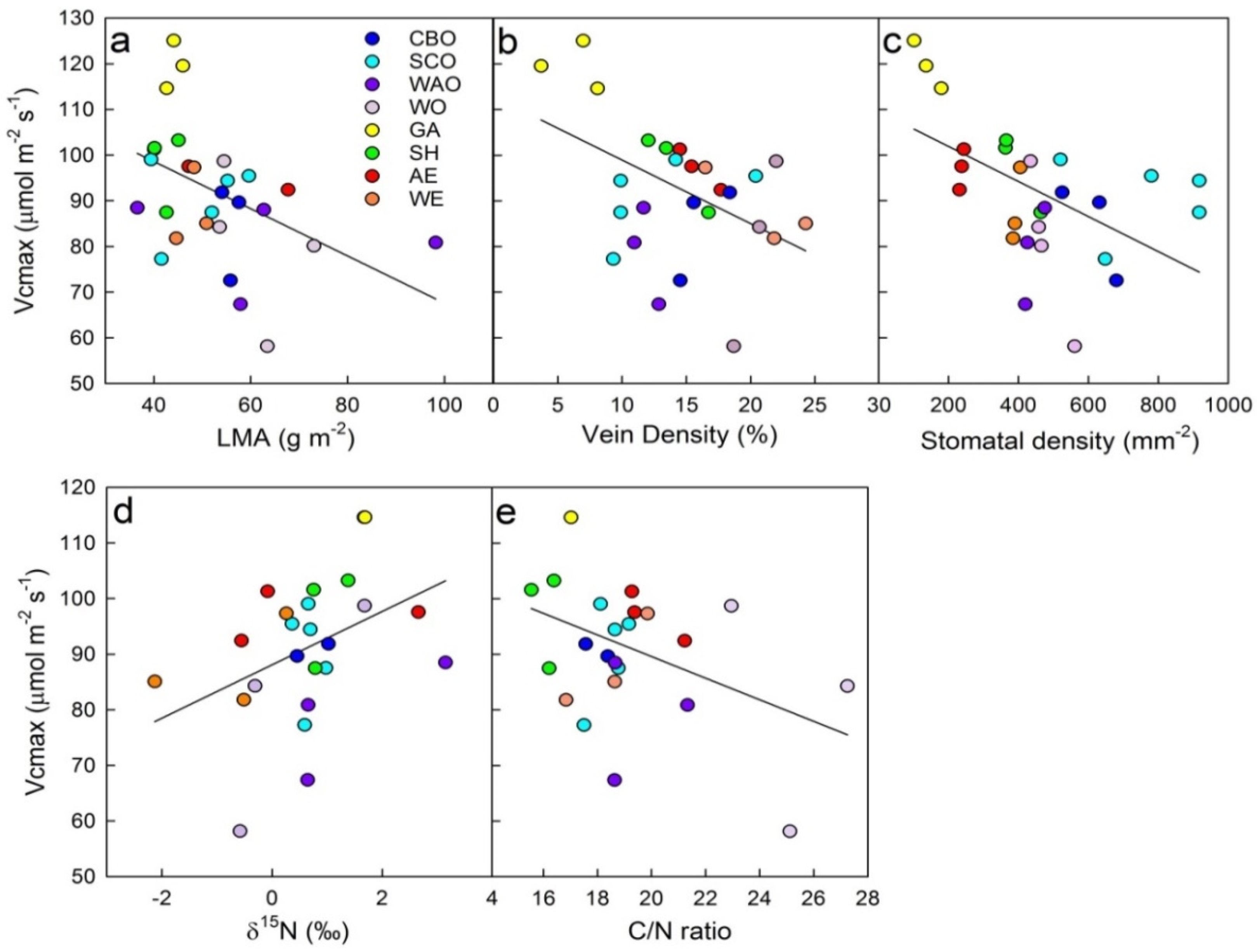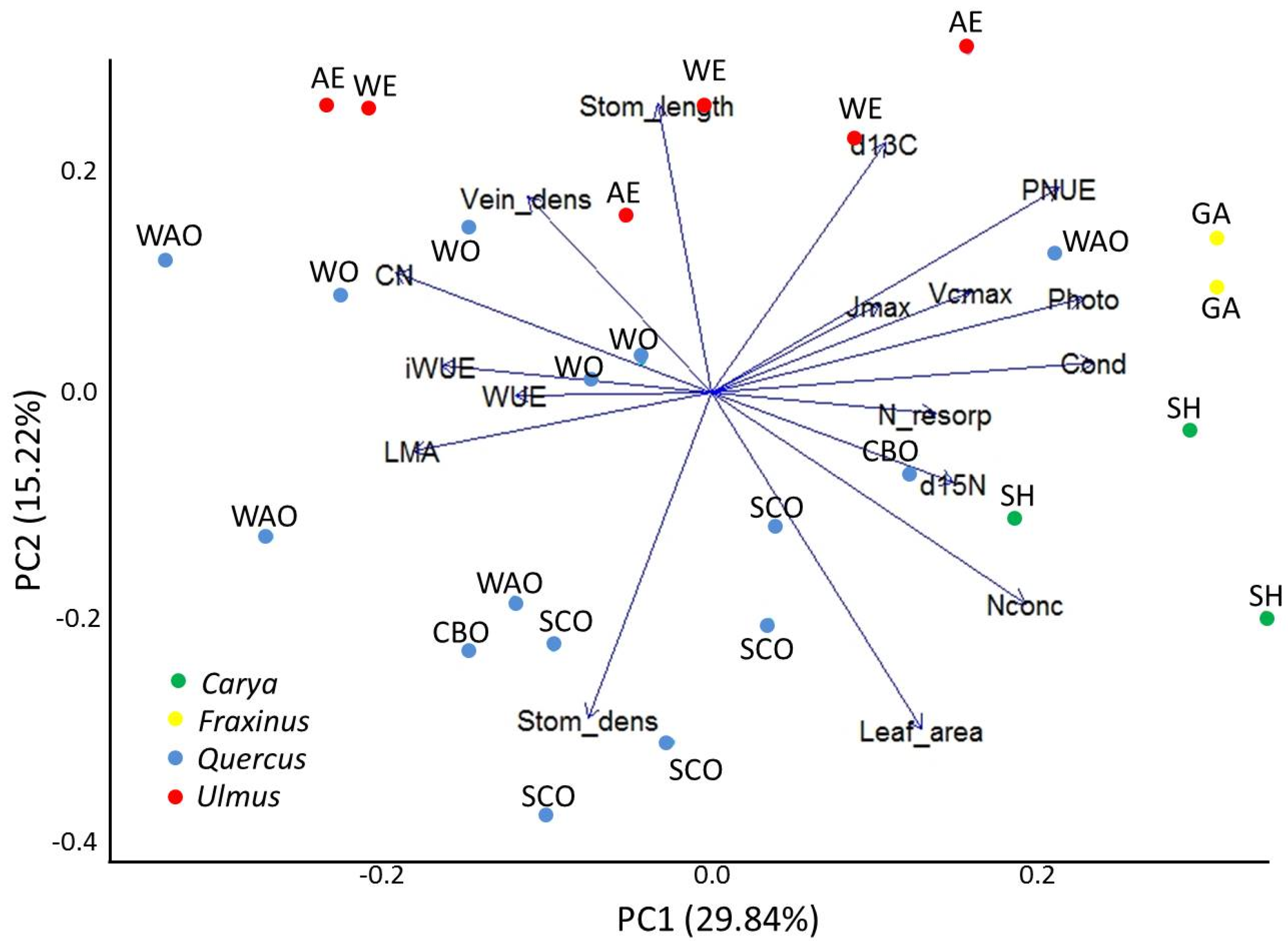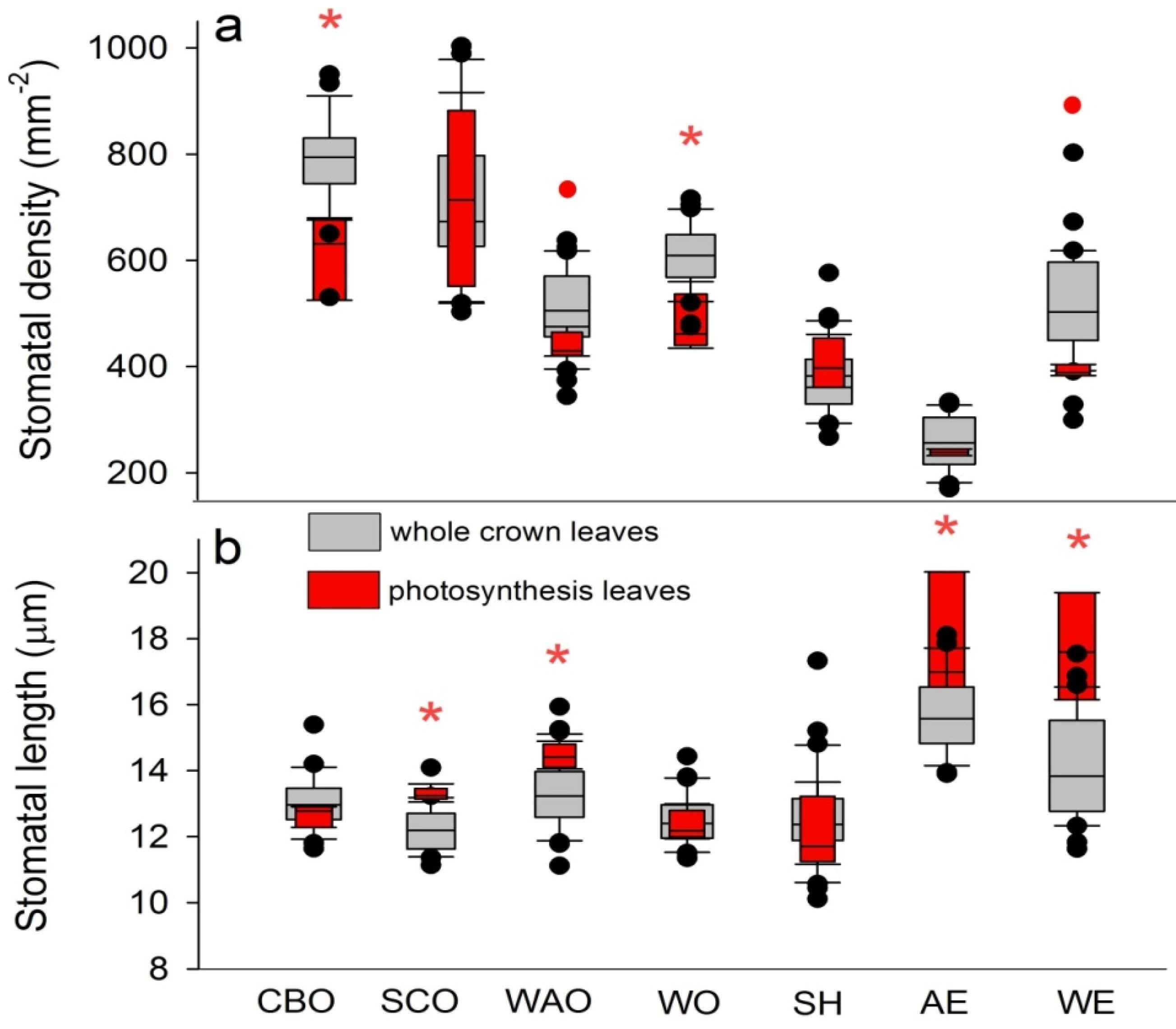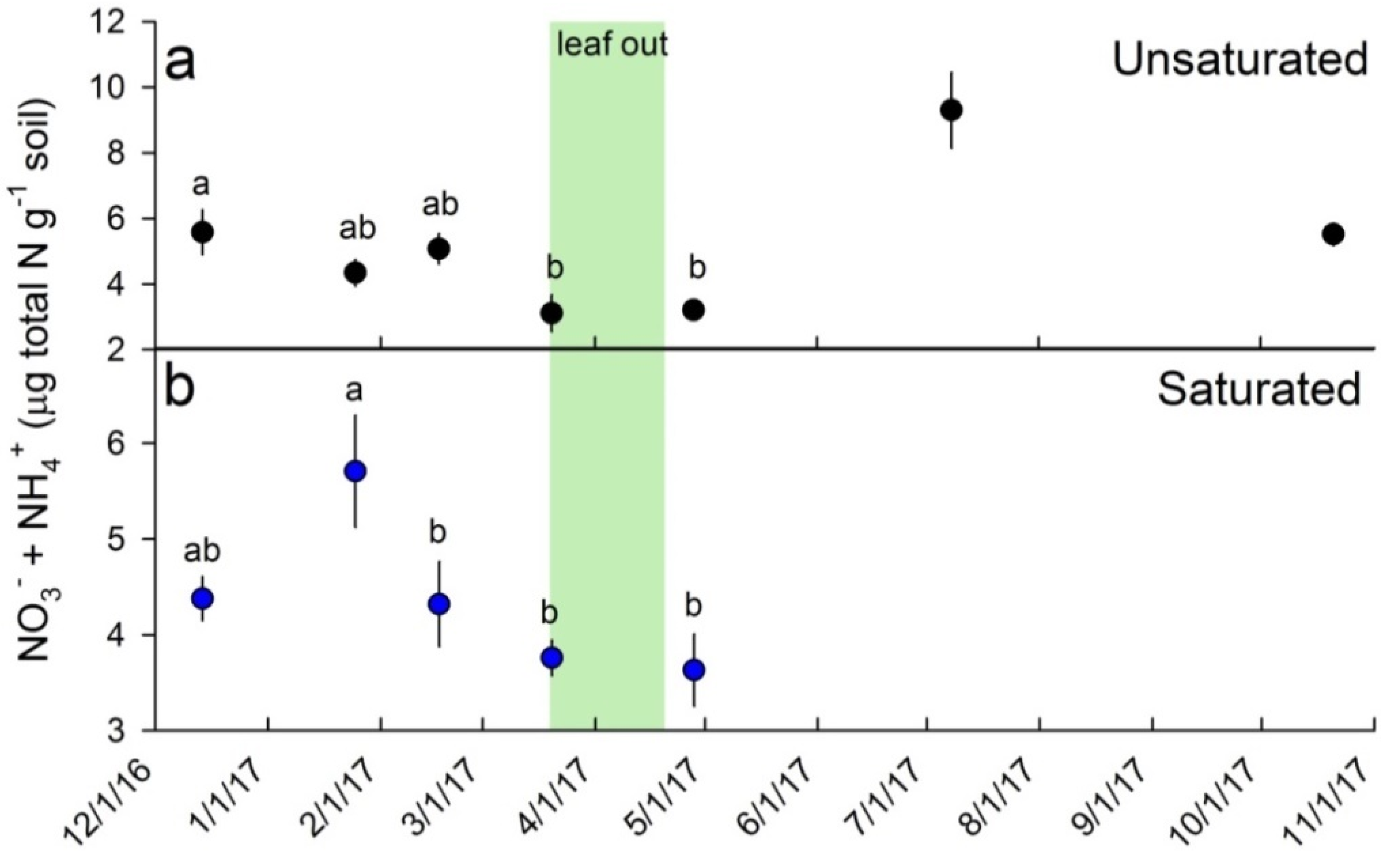Diversity or Redundancy in Leaf Physiological and Anatomical Parameters in a Species Diverse, Bottomland Hardwood Forest?
Abstract
1. Introduction
2. Materials and Methods
2.1. Site Description
2.2. Experimental Design and Tree-Level Characteristics for Intra-Crown Variability
2.3. Leaf-Level Photosynthetic Capacity for Inter-Species Comparison
2.4. Leaf-Level Nutrients, Isotopes and Foliar Anatomy for Comparison Within and Across Species
2.5. Soil Nitrogen
2.6. Statistical Analysis
3. Results
3.1. Comparison of Parameters within and across Species
3.2. Correlations between Physiological Parameters, Leaf Anatomy and Nutrients
3.3. Within Crown and Intra-Species Variation in Stomatal Properties
3.4. Soil Nitrogen During Inundation Periods
4. Discussion
4.1. Comparison of Parameters within and across Species
4.2. Correlations across Parameters
4.3. Intra-Species Variability in Stomatal Properties
4.4. Denitrification and N Limitations
5. Conclusions
Supplementary Materials
Author Contributions
Funding
Acknowledgments
Conflicts of Interest
References
- Battaglia, L.; Minchin, P.; Pritchett, D. Sixteen years of old-field succession and reestablishment of a bottomland hardwood forest in the Lower Mississippi Alluvial Valley. Wetlands 2002, 22, 1–17. [Google Scholar] [CrossRef]
- Hodges, J.D. Development and ecology of bottomland hardwood sites. Ecol. Manag. 1997, 90, 117–125. [Google Scholar] [CrossRef]
- McKnight, J.S.; Hook, D.D.; Langdon, O.G.; Johnson, R.L. Flood tolerance and related characteristics of trees of the bottomland forests of the southern United States. In Wetlands of Bottomland Hardwood Forests; Clark, J.R., Benfordado, J., Eds.; Elsevier Scientific Publishing Co: New York, NY, USA, 1981; pp. 28–69. [Google Scholar]
- Hurst, N.; White, J.R.; Baustian, J. Nitrate reduction in a hydrologically restored bottomland hardwood forest in the Mississippi river watershed, northern Louisiana. Soil Sci. Soc. Am. J. 2016, 80, 1698–1705. [Google Scholar] [CrossRef]
- Hunter, R.G.; Faulkner, S.P. Denitrification potentials in restored and natural bottomland hardwood wetlands. Soil Sci. Soc. Am. J. 2001, 65, 1865–1872. [Google Scholar] [CrossRef]
- Gardiner, E.S.; Oliver, J.M. Restoration of bottomland hardwood forests in the Lower Mississippi Alluvial Valley, USA. In Restoration of Boreal and Temperate Forests; Stanturf, J.A., Madsen, P., Eds.; CRC Press: Boca Raton, FL, USA, 2005; pp. 235–251. [Google Scholar]
- Rousseau, R.; Ezell, A.; Hodges, J.D. Bottomland Hardwood Management Species/Site Relationships; Mississippi State University: Mississippi State, MS, USA, 2004. [Google Scholar]
- Asner, G.P.; Martin, R.E.; Ford, A.J.; Metcalfe, D.J.; Liddell, M.J. Leaf chemical and spectral diversity in Australian tropical forests. Ecol. Appl. 2009, 19, 236–253. [Google Scholar] [CrossRef] [PubMed]
- Asner, G.P.; Martin, R.E.; Tupayachi, R.; Anderson, C.B.; Sinca, F.; Carranza-Jiménez, L.; Martinez, P. Amazonian functional diversity from forest canopy chemical assembly. Proc. Natl. Acad. Sci. USA 2014, 111, 5604–5609. [Google Scholar] [CrossRef]
- Reich, P.B.; Ellsworth, D.S.; Walters, M.B.; Vose, J.M.; Gresham, C.; Volin, J.C.; Bowman, W.D. Generality of leaf trait relationships: A test across six biomes. Ecology 1999, 80, 1955–1969. [Google Scholar] [CrossRef]
- Jucker, T.; Bouriaud, O.; Coomes, D.A. Crown plasticity enables trees to optimize canopy packing in mixed-species forests. Funct. Ecol. 2015, 29, 1078–1086. [Google Scholar] [CrossRef]
- Cadotte, M.W.; Carscadden, K.; Mirotchnick, N. Beyond species: Functional diversity and the maintenance of ecological processes and services. J. Appl. Ecol. 2011, 48, 1079–1087. [Google Scholar] [CrossRef]
- Zhang, Y.; Chen, H.Y.H.; Reich, P.B. Forest productivity increases with evenness, species richness and trait variation: A global meta-analysis. J. Ecol. 2012, 100, 742–749. [Google Scholar] [CrossRef]
- Schneider, F.D.; Morsdorf, F.; Schmid, B.; Petchey, O.L.; Hueni, A.; Schimel, D.S.; Schaepman, M.E. Mapping functional diversity from remotely sensed morphological and physiological forest traits. Nat. Commun. 2017, 8. [Google Scholar] [CrossRef] [PubMed]
- Aranda, I.; Forner, A.; Cuesta, B.; Valladares, F. Species-specific water use by forest tree species: From the tree to the stand. Agric. Water Manag. 2012, 114, 67–77. [Google Scholar] [CrossRef]
- Violle, C.; Reich, P.B.; Pacala, S.W.; Enquist, B.J.; Kattge, J. The emergence and promise of functional biogeography. Proc. Natl. Acad. Sci. USA 2014, 111, 13690–13696. [Google Scholar] [CrossRef] [PubMed]
- Bögelein, R.; Thomas, F.M.; Kahmen, A. Leaf water 18O and 2H enrichment along vertical canopy profiles in a broadleaved and a conifer forest tree. Plant Cell Environ. 2017, 40, 1086–1103. [Google Scholar] [CrossRef] [PubMed]
- Hetherington, A.; Woodward, F.I. The role of stomata in sensing and driving environmental change. Nature 2003, 424, 901–908. [Google Scholar] [CrossRef] [PubMed]
- Keenan, T.F.; Niinemets, U. Global leaf trait estimates biased due to plasticity in the shade. Nat. Plants 2016, 3. [Google Scholar] [CrossRef]
- Escribano-Rocafort, A.G.; Ventre-Lespiaucq, A.B.; Granado-Yela, C.; Rubio de Casas, R.; Delgado, J.A.; Escudero, A.; Balaguer, L. Intraindividual variation in light-related functional traits: Magnitude and structure of leaf trait variability across global scales in Olea europaea trees. Trees 2017, 31, 1505–1517. [Google Scholar] [CrossRef]
- Natural Resources Conservation Service. United States Department of Agriculture. Web Soil Survey. Available online: https://websoilsurvey.sc.egov.usda.gov/App/HomePage.htm/ (accessed on 17 April 2018).
- Arguez, A.; Durre, I.; Applequist, S.; Squires, M.; Vose, R.; Yin, X.; Bilotta, R. NOAA’s U.S. Climate normals (1981–2010). NOAA Natl. Cent. Environ. Inf. 2010. [Google Scholar] [CrossRef]
- Kassahun, Z. The Influence of Environmental Factors on the Physiological Function of Eight Co-Occurring Species on a Minor Bottomland Hardwood Stand; Mississippi State University: Mississippi State, MS, USA, 2018. [Google Scholar]
- Sharkey, T.D.; Bernacchi, C.; Farquhar, G.D.; Singsaas, E. Fitting photosynthetic carbon dioxide response curves for C3 leaves. Plant Cell Environ. 2007, 30, 1035–1040. [Google Scholar] [CrossRef]
- Maynard, D.G.; Kalra, Y.P. Nitrate and exchangeable ammonium nitrogen. In Soil Sampling and Methods of Analysis; Carter, M.R., Ed.; Lewis Publishers: Boca Raton, FL, USA, 1993; pp. 25–38. [Google Scholar]
- R Core Team. R: A Language and Environment for Statistical Computing; R Foundation for Statistical Computing: Vienna, Austria, 2014. [Google Scholar]
- Santiago, L.S.; Wright, S.J. Leaf functional traits of tropical forest plants in relation to growth form. Funct. Ecol. 2007, 21, 19–27. [Google Scholar] [CrossRef]
- Farquhar, G.D.; Ehleringer, J.R.; Hubick, K.T. Carbon isotope discrimination and photosynthesis. Annu. Rev. Plant Physiol. Plant Mol. Biol. 1989, 40, 503–537. [Google Scholar] [CrossRef]
- Monclus, R.; Dreyer, E.; Villar, M.; Delmotte, F.; Delay, D.; Petit, J.; Barbaroux, C.; Le Thiec, D.; Bréchet, C.; Brignolas, F. Impact of drought on productivity and water use efficiency in 29 genotypes of Populus deltoides × Populus nigra. New Phytol. 2006, 169, 765–777. [Google Scholar] [CrossRef] [PubMed]
- Warren, C.R.; Adams, M.A. Internal conductance does not scale with photosynthetic capacity: Implications for carbon isotope discrimination and the economics of water and nitrogen use in photosynthesis. Plant Cell Environ. 2006, 29, 192–201. [Google Scholar] [CrossRef] [PubMed]
- Ponton, S.; Dupouey, J.L.; Bréda, N.; Dreyer, E. Comparison of water-use efficiency of seedlings from two sympatric oak species: Genotype x environment limitation. Tree Physiol. 2002, 22, 413–422. [Google Scholar] [CrossRef]
- Ripullone, F.; Lauteri, M.; Grassi, G.; Amato, M.; Borghetti, M. Variation in nitrogen supply changes water-use efficiency of Pseudotsuga menziesii and Populus × euroamericana; a comparison of three approaches to determine water-use efficiency. Tree Physiol. 2004, 24, 671–679. [Google Scholar] [CrossRef]
- Marks, C.O.; Lechowicz, M.J. Alternative designs and the evolution of functional diversity. Am. Nat. 2006, 167, 55–66. [Google Scholar] [CrossRef]
- Scartazza, A.; Di Baccio, D.; Bertolotto, P.; Gavrichkova, O.; Matteucci, G. Investigating the European beech (Fagus sylvatica L.) leaf characteristics along the vertical canopy profile: Leaf structure, photosynthetic capacity, light energy dissipation and photoprotection mechanisms. Tree Physiol. 2016, 36, 1060–1076. [Google Scholar] [CrossRef]
- Ellsworth, D.S.; Reich, P.B. Canopy structure and vertical patterns of photosynthesis and related leaf traits in a deciduous forest. Oecologia 1993, 96, 169–178. [Google Scholar] [CrossRef]
- Carins Murphy, M.R.; Jordan, G.J.; Brodribb, T.J. Cell expansion not cell differentiation predominantly co-ordinates veins and stomata within and among herbs and woody angiosperms grown under sun and shade. Ann. Bot. 2016. [Google Scholar] [CrossRef]
- Craine, J.M.; Elmore, A.J.; Aidar, M.P.M.; Bustamante, M.; Dawson, T.E.; Hobbie, E.A.; Kahmen, A.; Mack, M.C.; McLauchlan, K.K.; Michelsen, A.; et al. Global patterns of foliar nitrogen isotopes and their relationships with climate, mycorrhizal fungi, foliar nutrient concentrations, and nitrogen availability. New Phytol. 2009, 183, 980–992. [Google Scholar] [CrossRef]
- Templer, P.H.; Arthur, M.A.; Lovett, G.M.; Weathers, K.C. Plant and soil natural abundance δ15N: Indicators of relative rates of nitrogen cycling in temperate forest ecosystems. Oecologia 2007, 153, 399–406. [Google Scholar] [CrossRef] [PubMed]
- Garten, C.T., Jr.; van Miegroet, H. Relationships between soil nitrogen dynamics and natural 15N abundance in plant foliage from great smoky mountains national park. Can. J. Res. 1994, 24, 1636–1645. [Google Scholar] [CrossRef]
- Broeckx, L.; Fichot, R.; Verlinden, M.; Ceulemans, R. Seasonal variations in photosynthesis, intrinsic water-use efficiency and stable isotope composition of poplar leaves in a short-rotation plantation. Tree Physiol. 2014, 34, 701–715. [Google Scholar] [CrossRef] [PubMed]
- Field, C.; Merino, J.; Mooney, H.A. Compromises between water-use efficiency and nitrogen-use efficiency in five species of California evergreens. Oecologia 1983, 60, 384–389. [Google Scholar] [CrossRef] [PubMed]
- Renninger, H.J.; Carlo, N.J.; Clark, K.L.; Schäfer, K.V.R. Resource use and efficiency, and stomatal responses to environmental drivers of oak and pine species in an Atlantic coastal plain forest. Front. Plant Sci. 2015, 6, 297. [Google Scholar] [CrossRef]
- Poorter, H.; Evans, J.R. Photosynthetic nitrogen-use efficiency of species that differ inherently in specific leaf area. Oecologia 1998, 116, 26–37. [Google Scholar] [CrossRef] [PubMed]
- DeLucia, E.H.; Schlesinger, W.H. Photosynthetic rates and nutrient-use efficiency among evergreen and deciduous shrubs in Okefenokee Swamp. Int. J. Plant Sci. 1995, 156, 19–28. [Google Scholar] [CrossRef]
- Takashima, T.; Hikosaka, K.; Hirose, T. Photosynthesis or persistence: Nitrogen allocation in leaves of evergreen and deciduous Quercus species. Plant Cell Environ. 2004, 27, 1047–1054. [Google Scholar] [CrossRef]
- Yoder, B.J.; Ryan, M.G.; Waring, R.H.; Schoettle, A.W.; Kaufman, M.R. Evidence of reduced photosynthetic rates in old trees. Forest Sci. 1994, 40, 513–527. [Google Scholar]
- Ryan, M.G.; Phillips, N.; Bond, B.J. The hydraulic limitation hypothesis revisited. Plant Cell Environ. 2006, 29, 367–381. [Google Scholar] [CrossRef]
- Drake, P.L.; Froend, R.H.; Franks, P.J. Smaller, faster stomata: Scaling of stomatal size, rate of response, and stomatal conductance. J. Exp. Bot. 2013, 64, 495–505. [Google Scholar] [CrossRef] [PubMed]
- Abrams, M.D.; Kubiske, M.E. Leaf structural characteristics of 31 hardwood and conifer tree species in central Wisconsin: Influence of light regime and shade-tolerance rank. Ecol. Manag. 1990, 31, 245–253. [Google Scholar] [CrossRef]
- Quero, J.L.; Villar, R.; Marañón, T.; Zamora, R. Interactions of drought and shade effects on seedlings of four Quercus species: Physiological and structural leaf responses. New Phytol. 2006, 170, 819–834. [Google Scholar] [CrossRef] [PubMed]
- Beerling, D.J.; Kelly, C.K. Stomatal density responses of temperate woodland plants over the past seven decades of CO2 increase: A comparison of Salisbury (1927) with contemporary data. Am. J. Bot. 1997, 84, 1572–1583. [Google Scholar] [CrossRef] [PubMed]
- Sack, L.; Melcher, P.J.; Liu, W.H.; Middleton, E.; Pardee, T. How strong is intracanopy plasticity in temperate deciduous trees? Am. J. Bot. 2006, 93, 829–839. [Google Scholar] [CrossRef] [PubMed]
- Le Roux, X.; Sinoquet, H.; Vandame, M. Spatial distribution of leaf dry weight per area and leaf nitrogen concentration in relation to local radiation regime within an isolated tree crown. Tree Physiol. 1999, 19, 181–188. [Google Scholar] [CrossRef]
- Koike, T.; Kitao, M.; Maruyama, Y.; Mori, S.; Lei, T.T. Leaf morphology and photosynthetic adjustments among deciduous broad-leaved trees within the vertical canopy profile. Tree Physiol. 2001, 21, 951–958. [Google Scholar] [CrossRef]
- Langhans, S.D.; Tockner, K. The role of timing, duration, and frequency of inundation in controlling leaf litter decomposition in a river-floodplain ecosystem (Tagliamento, northeastern Italy). Oecologia 2006, 147, 501–509. [Google Scholar] [CrossRef]
- Dodla, S.K.; Wang, J.J.; DeLaune, R.D.; Cook, R.L. Denitrification potential and its relation to organic carbon quality in three coastal wetland soils. Sci. Total Environ. 2008, 407, 471–480. [Google Scholar] [CrossRef]
- Glazebrook, H.S.; Robertson, A.I. The effect of flooding and flood timing on leaf litter breakdown rates and nutrient dynamics in a river red gum (Eucalyptus camaldulensis) forest. Austral Ecol. 1999, 24, 625–635. [Google Scholar] [CrossRef]
- Yan, E.R.; Wang, X.H.; Guo, M.; Zhong, Q.; Zhou, W.; Li, Y.F. Temporal patterns of net soil n mineralization and nitrification through secondary succession in the subtropical forests of eastern China. Plant Soil 2009, 320, 181–194. [Google Scholar] [CrossRef]
- Gilliam, F.S.; Yurish, B.M.; Adams, M.B. Temporal and spatial variation of nitrogen transformations in nitrogen-saturated soils of a central Appalachian hardwood forest. Can. J. Res. 2001, 31, 1768–1785. [Google Scholar] [CrossRef]
- Schrumpf, M.; Kaiser, K.; Schulze, E.D. Soil organic carbon and total nitrogen gains in an old growth deciduous forest in Germany. PLoS ONE 2014, 9, e89364. [Google Scholar] [CrossRef] [PubMed][Green Version]






| Cherrybark Oak | Swamp Chestnut Oak | Water Oak | Willow Oak | Green Ash | Shagbark Hickory | American Elm | Winged Elm | |
|---|---|---|---|---|---|---|---|---|
| VCmax (μmol m−2 s−1) | 84.7 (6.1) B | 90.7 (3.9) B | 81.2 (4.9) B | 80.3 (8.4) B | 118.5 (2.5) A | 97.7 (5.0) B | 97.1 (2.6) B | 88.1 (4.7) B |
| Jmax (μmol m−2 s−1) | 132.8 (4.4) ab | 131.2 (7.1) ab | 111.3 (5.5) b | 134.3 (10.9) ab | 146.9 (2.2) a | 121.3 (9.6) ab | 139.6 (0.8) ab | 120.9 (6.1) ab |
| Photosynthetic rate (μmol m−2 s−1) | 5.4 (1.6) B | 5.3 (0.5) B | 6.0 (0.7) B | 5.4 (0.6) B | 9.1 (1.0) A | 8.0 (0.5) AB | 6.0 (1.4) B | 6.5 (1.2) B |
| Transpiration rate (mmol m−2 s−1) | 1.6 (0.5) B | 1.5 (0.2) B | 1.8 (0.3) B | 2.2 (0.4) B | 4.9 (0.9) A | 3.0 (0.3) B | 1.7 (0.3) B | 1.9 (0.3) B |
| Water use efficiency (μmol mmol−1) | 3.4 (0.3) A | 3.5 (0.2) A | 3.4 (0.4) A | 2.7 (0.5) A | 1.9 (0.2) B | 2.8 (0.3) AB | 3.4 (0.2) A | 3.4 (0.1) A |
| Stomatal conductance (mol m−2 s−1) | 0.07 (0.02) B | 0.07 (0.01) B | 0.08 (0.02) B | 0.10 (0.02) B | 0.25 (0.07) A | 0.14 (0.01) AB | 0.08 (0.02) B | 0.08 (0.02) B |
| Intrinsic WUE (μmol mol−1) | 84.3 (8.1) A | 80.0 (7.4) A | 85.2 (14.6) A | 65.3 (14.9) A | 42.6 (8.0) B | 56.5 (4.4) AB | 81.0 (5.1) A | 82.3 (5.0) A |
| δ13C (‰) | −30.9 (0.7) B | −30.5 (0.2) B | −30.4 (0.5) B | −30.4 (0.5) B | −30.1 (0.1) AB | −29.6 (0.4) AB | −29.8 (0.2) A | −29.3 (0.3) A |
| N concentration (%) | 2.7 (0.03) a | 2.4 (0.1) ab | 2.3 (0.1) ab | 2.0 (0.1) b | 2.6 (0.1) ab | 2.8 (0.1) a | 2.1 (0.1) b | 2.3 (0.2) ab |
| C/N ratio | 17.9 (0.3) bc | 18.4 (0.3) bc | 20.5 (1.1) b | 24.5 (1.1) a | 17.0 (0.05) bc | 16.1 (0.3) c | 20.0 (0.6) bc | 18.4 (0.9) bc |
| PNUE (μmol g−1 N s−1) | 4.6 (1.0) | 4.4 (0.3) | 4.9 (2.1) | 5.1 (0.4) | 6.8 (0.3) | 6.8 (0.4) | 6.0 (1.9) | 6.0 (1.1) |
| N resorption (%) | 47.3 (0.5) ab | 53.4 (2.8) ab | 45.0 (2.7) b | 57.2 (2.3) a | 58.5 (1.7) a | 55.7 (0.8) ab | 44.2 (2.78) b | 57.4 (3.1) a |
| δ15N (‰) | 0.64 (0.2) | 0.66 (0.010) | 0.77 (0.92) | 0.40 (0.5) | 1.68 (0.008) | 0.97 (0.02) | 0.67 (1.0) | −0.79 (0.7) |
| Cherrybark Oak | Swamp Chestnut Oak | Water Oak | Willow Oak | Green Ash | Shagbark Hickory | American Elm | Winged Elm | |
|---|---|---|---|---|---|---|---|---|
| Leaf mass per area (g m−2) | 56.2 (0.8) | 48.5 (3.9) | 62.7 (10.0) | 61.6 (3.6) | 43.8 (0.8) | 42.6 (1.4) | 51.6 (8.3) | 47.9 (1.8) |
| Leaf (or leaflet) area (cm2) | 103.0 (15.0) ab | 143.3 (11.9) a | 32.0 (14.2) c | 29.3 (3.8) c | 56.4 (9.2) bc | 148.9 (33.5) a | 44.5 (1.1) bc | 17.9 (1.4) c |
| Stomatal length (μm) | 13.0 (0.1) c | 12.7 (0.2) cd | 13.1 (0.2) c | 12.5 (0.1) c | 17.2 (0.2) a | 11.3 (0.3) d | 15.7 (0.2) a | 14.1 (0.3) b |
| Stomatal density (mm−2) | 786 (16.9) a | 713 (30.7) a | 506 (14.1) c | 608 (11.0) b | 149 (19.0) e | 388 (12.4) d | 254 (10.2) e | 508 (18.9) c |
| Vein density (%) | 16.2 (1.1) ab | 13.4 (2.6) bc | 13.1 (1.3) abc | 20.4 (1.0) a | 6.2 (1.3) c | 15.6 (1.8) ab | 15.9 (1.0) ab | 20.9 (2.3) a |
| Parameters | Diversity Quotients |
|---|---|
| VCmax | 1.5 |
| Jmax | 1.3 |
| Photosynthetic rate | 1.7 |
| Transpiration rate | 3.3 |
| Water use efficiency | 1.8 |
| Stomatal conductance | 3.6 |
| Intrinsic WUE | 2.0 |
| δ13C | 1.0 |
| N concentration | 1.4 |
| C/N ratio | 1.5 |
| PNUE | 1.5 |
| N resorption | 1.3 |
| Leaf mass per area | 1.5 |
| Leaf or leaflet area | 8.3 |
| Stomatal length | 1.7 |
| Stomatal density | 5.1 |
| Vein density | 3.4 |
© 2020 by the authors. Licensee MDPI, Basel, Switzerland. This article is an open access article distributed under the terms and conditions of the Creative Commons Attribution (CC BY) license (http://creativecommons.org/licenses/by/4.0/).
Share and Cite
Kassahun, Z.; Yow, J.N.; Renninger, H.J. Diversity or Redundancy in Leaf Physiological and Anatomical Parameters in a Species Diverse, Bottomland Hardwood Forest? Forests 2020, 11, 519. https://doi.org/10.3390/f11050519
Kassahun Z, Yow JN, Renninger HJ. Diversity or Redundancy in Leaf Physiological and Anatomical Parameters in a Species Diverse, Bottomland Hardwood Forest? Forests. 2020; 11(5):519. https://doi.org/10.3390/f11050519
Chicago/Turabian StyleKassahun, Zeima, Justin N. Yow, and Heidi J. Renninger. 2020. "Diversity or Redundancy in Leaf Physiological and Anatomical Parameters in a Species Diverse, Bottomland Hardwood Forest?" Forests 11, no. 5: 519. https://doi.org/10.3390/f11050519
APA StyleKassahun, Z., Yow, J. N., & Renninger, H. J. (2020). Diversity or Redundancy in Leaf Physiological and Anatomical Parameters in a Species Diverse, Bottomland Hardwood Forest? Forests, 11(5), 519. https://doi.org/10.3390/f11050519





